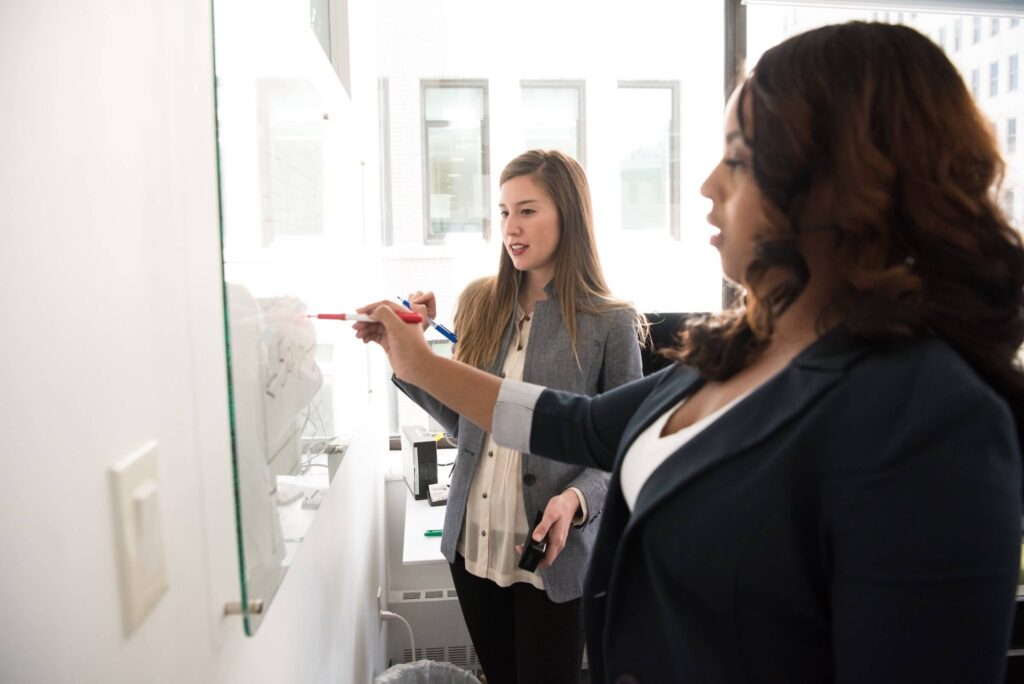Introduction
Collaborative learning is one of the “secret weapons” of a growing company. It is a crucial ingredient that enables scale while fostering culture, creating the conditions for greater productivity while ensuring that employees feel a collective sense of ownership and accomplishment in what they are building. Collaborative learning is larger than any single tool or platform; it is a thorough and well considered methodology that influences many of a company’s operations. This deep dive explores collaborative learning’s role, contrasts it with formal learning, and illustrates its impact through practical examples, particularly within software engineering teams.
Comparing collaborative learning and formal learning
In describing the role of collaborative learning, it’s helpful to first articulate what it isn’t. Its counterpart, formal learning, is in some ways more obvious and well known. Formal learning is a top-down process often led by the HR department or other learning and development professionals. Formal learning uses static presentations that are light on interactivity to convey important information that has a limited role in how people actually go about performing their daily tasks. Examples of informal learning include mandatory reviews of a company’s sexual harassment policy, data management strategies, or overviews on how employment benefits are administered. Collaborative learning, by contrast, is fluid, adapting to real-time organizational needs and fostering active knowledge sharing.
Understanding the limits of static learning
Due in large part to its evergreen nature, this sort of thing is often easy to outsource. Content libraries such as LinkedIn Learning do an excellent job providing buttoned up, “one-size-fits-all” materials that make hard and fast assumptions about what an employee does and does not know. While these tools certainly have a place in a company’s toolbox they are not a holistic solution, as they fail to address a range of developmental needs, and often offer little in relation to what is actually happening on the ground at that very moment. As a result, formal learning is best used to convey information with a shelf life that can be measured in quarters or even years. It is a strong tool for teaching employees about topics that tend not to change much.
Collaborative learning as a tool for agility
Critical though it is, formal learning leaves many holes in a company’s long term developmental strategy. It isn’t agile enough to help new employees quickly understand the demands of, say, a fast growing engineering department. Due to the static nature of its materials, new videos or powerpoint presentations are difficult, if not impossible, to roll out when a sudden crisis or opportunity presents itself. What is more, these materials can be incredibly expensive; a single hour long formal learning video can easily require 100 hours of labor to produce. Collaborative learning, then, is the tool that fills in these gaps; it is a nimble, responsive system that empowers people to stand up and share their knowledge directly with their peers, further enabling development and growth. Built correctly, these are the tools that ensure that growing, morphing teams can meet any and all challenges.
The power of collaboraitve learning in practice
People learn best from one another
It’s fair to say that I didn’t fully appreciate the potential of collaborative learning until circumstances forced me to tap into it. While working at Twitter, management asked me to teach my co-workers the ins and outs of Android. I was the obvious candidate for this job, as I literally wrote a book on the subject. My initial instinct was that people should simply read that book, but that solution generated little enthusiasm. My co-workers considered the book “too vanilla”, as it was an overview, and wasn’t geared towards the topic of how Android could most effectively be deployed at Twitter specifically.
As a result of this feedback, I went around to the company’s subject matter experts, surveying them on how they were using Android, combining their experience with my overall knowledge of the Android coding language. By doing this, I came to appreciate that Twitter was quickly and consistently innovating on Android, and that trainings would be poorly served by my unchanging book. People looking to learn would require lively discussions with back and forth exchanges and ample opportunity for questions.
Find your subject-matter-experts (SMEs), and create in-house inventory of “who knows what”
These sessions quickly proved both popular and effective, and were soon codified into formal offerings. Things didn’t stop simply with Android. Management quickly recognized the opportunity inherent in identifying and utilizing subject matter experts, and moved to replicate this success on a host of topics. Not long after my experiment in teaching Android, the company was offering similarly organized orientation classes for new engineers on iOS Bootcamp, JVM Fundamentals, Distributed Systems, Scala School, and much more. It wasn’t difficult to find the talent to lead these sessions; Twitter already had the engineers in-house who possessed the requisite expertise and enthusiasm for education.
Host all your expertise in one place and give it an official name
As Twitter continued to grow, management realized it was critical for the engineers to have ongoing access to world-class technical training. Furthermore, they discovered that as these same engineers achieved mastery of certain subjects, they demonstrated incredible enthusiasm and aptitude for turning around and teaching the latest new comers at the company. To that end, Twitter University was born. This centralized location made it easy to find and access the vast, untapped expertise that existed throughout the company.
Create live workshops that can leep up with fast-evolving knowledge
More than anything, this process made clear how critical it is to ask practical questions when it comes to learning. Specifically, how do you get people to enthusiastically and efficiently participate in the process? Fast growing companies confront a number of situations in which they are trying to tutor hundreds or even even thousands of people on new subjects. A reliance on formal learning tools to address this need would require the creation of underwhelming PowerPoint presentations and expensive videos. There would be a considerable delay between the decision to pursue these trainings and the day in which the materials were ready for circulation.
My time at Twitter taught me that collaborative learning cuts out these delays while also creating excitement and a sense of joint ownership. Employees almost unanimously prefer a more fluid, live workshop featuring an employee standing in front of a whiteboard over another tedious deck clogging up their inboxes like a heavy weight. This process of collaboration gives employees the satisfaction that comes with using their own voice to ask their own questions. Interaction like this works as a positive feedback loop; it reveals what the workforce already understands and doesn’t yet grasp, giving the company real time and efficient feedback on its workforce development.
Consider first who should create learning materials when decisding between formal and informal modalities
None of this is to say that formal learning tools have no place in today’s workforce; these options are not zero sum. Fast moving situations and innovations are best serviced by collaborative learning. As they inevitably slow down and cease to evolve, they become knowledge which can in fact be transmitted by something more static. One of the best ways to distinguish between these scenarios is to ask who in the company is best fit to own this content creation. If the most suitable employees are subject matter experts, they’re almost certainly better off using collaborative learning methodology. If, however, the learning and development professionals are put in charge, they would play to their strengths and use formal learning tools which optimize for content polish and production value.
Dedicated time is key
Set a specific date and time to better encourage learning
As collaborative learning processes ramp up and multiply, a number of other benefits begin to show. The agility of these tools makes it easy to refresh the content, ensuring that relevant lessons never go out of date, while standing up new ones remains easy and cost effective. They also generate culture by allowing employees to get to know and mentor one another. This furthers company cohesion and a collective sense of responsibility and success. What is more, because of their live, scheduled nature, collaborative learning sessions force employees into action.
It might seem that a video is exceptionally convenient because of the fact that it can be accessed at any time. In fact, though, that convenience serves as a double edged sword. In situations like these, when a lesson is available at any time it rarely, if ever, becomes the time to absorb it. There will always be a reason that keeps an employee from carving out the time and clicking on the link. It could be procrastination or, more charitably, it could be an endless string of deadlines which always take precedent. Collaborative learning sessions, on the other hand, force people to show up at a given date and time and learn from their peers.
Recognize and reward your SMEs
Collaborative learning can also ease the burden of an already overworked management team, taking responsibility for aspects of onboarding and continuing education out of their hands and reassigning them to a larger population. Tapping into the collective wisdom of the workforce keeps the company from being overly reliant on any single individual, while also enabling the discovery of new “experts” hidden amongst the workforce.
Conclusion
Collaborative learning represents a dynamic shift in the way companies approach development and knowledge sharing, transforming traditional educational paradigms into interactive, community-driven experiences. This methodology does more than just impart knowledge; it builds relationships, fosters a sense of belonging, and cultivates an environment where employees are empowered to share, learn, and grow together.
The strength of collaborative learning lies in its ability to adapt to the ever-changing landscape of a growing company, ensuring that learning remains relevant, engaging, and in sync with real-world applications. It encourages a culture of mutual support where everyone, from new hires to seasoned experts, plays a vital role in the collective success of the organization.
By embracing the principles of collaborative learning, companies not only enhance their ability to innovate and adapt but also create a workplace where employees feel valued and connected. This sense of community and shared purpose is what ultimately leads to a thriving, resilient company culture, capable of attracting and retaining top talent.
In conclusion, collaborative learning is not just a method but a mindset, one that champions continuous improvement, teamwork, and the recognition that everyone has something valuable to teach and learn. It is a testament to the power of collective intelligence and a reminder that, together, we can achieve far more than we ever could alone.
Incorporating social activities into the onboarding process is also a must-have. Whether it’s a virtual coffee break or an in-person team-building activity, these events help new hires build relationships and feel part of the team. They also provide a more relaxed setting for informal learning and knowledge sharing.







